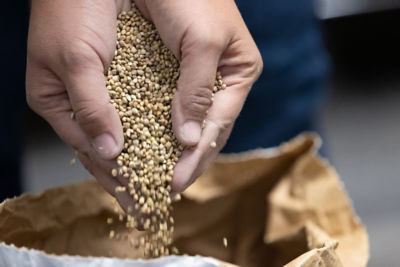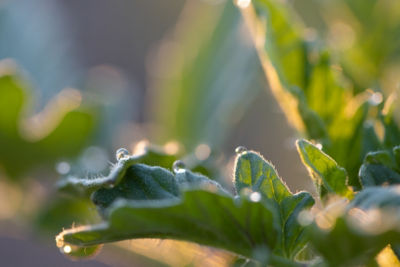Click here to download a PDF version of this spotlight.
» Bacterial (leaf) spot is one of the most damaging diseases of pepper.
» An integrated disease management program provides the best control of this disease.
» Disease resistance is an important component of disease control.
THE CAUSES OF BACTERIAL SPOT
Four different species belonging to the bacterial genus Xanthomonas have been identified as causing bacterial spot of pepper, tomato, and other solanaceous plants. Of these, the species Xanthomonas euvesicatoria is the most common cause of the disease on peppers in North America.1 There are strains of the pathogen that only infect peppers, strains that only infect tomato, and strains that can infect both crop species, which can be important where the two crops are grown in close proximity.
Another leaf spot disease of peppers that may be confused with bacterial spot is called Syringae seedling blight and leaf spot. This disease usually only develops on young seedlings, causing small spots on the cotyledons and first true leaves. Severe infections can kill young seedlings. However, older tissues are generally not affected, and infected seedlings can recover. Unlike bacterial spot, which is favored by warm temperatures, Syringae seedling blight and leaf spot develops best at relatively cool temperatures, between 61 and 75°F.2,3 This disease is not common and has limited distribution in North America.
BACTERIAL SPOT SYMPTOMS
Bacterial spot on peppers first appears as small, water-soaked areas on the undersides of leaves. These areas can quickly enlarge into spots that are up to ¼ inch in diameter, turn dark brown and become slightly raised (Figure 1). On the upper sides of leaves, the spots are slightly depressed with brown borders and beige centers. Infected leaves turn yellow and drop prematurely. This defoliation can expose developing fruit to sunscald, and the loss of leaves reduces the plant’s ability to adequately support fruit development.1,4
The pathogen can also infect the fruit, and there are significant losses from the shedding of blossoms and abortion of developing fruit. Any remaining fruit may not be marketable due to small size, deformities, and brown, circular lesions. The spot bacteria do not rot fruit directly, but lesions on fruit can provide an entrance for other fruit rotting pathogens, resulting in fruit decay.
 Figure 1. Initial water-soaking symptoms and older necrotic lesions of bacterial spot on pepper.
Figure 1. Initial water-soaking symptoms and older necrotic lesions of bacterial spot on pepper.
FAVORABLE CONDITIONS
Bacterial spot develops most rapidly during periods of warm temperatures and prolonged wet conditions.4 The pathogen survives in and on seed and in plant debris.1,5 Commercially produced seed is often treated to reduce the presence of the pathogen. However, even a low seed infection rate can result in significant levels of disease developing in the field.4
The disease can also be brought in on infected transplants.4 It is possible for the pathogen to survive on the surface of transplants, causing no visible symptoms, and these asymptomatic, infested seedlings can be an important source of infection once they are transplanted into a field.
The pathogen can also survive in the field on infested crop debris for a limited amount of time. Persistence of debris (and pathogen) depends on environmental conditions, and the pathogen can survive in debris for at least a year in some situations. Infected weed and volunteer host plants may also be sources of inoculum.6
CONTROL
The control of bacterial spot requires an integrated program of management strategies. The use of certified, disease free seed and transplants is highly recommended. Seed treatments with hot water or chemicals can effectively reduce levels of bacteria on and in the seed, but such treatments can also lower seed viability and may void seed company guarantees if done by the grower. Seed treatments alone have not been sufficient to adequately control bacterial spot.7
To protect seedlings during transplant production, a number of important guidelines should be followed. Greenhouse benches, surfaces, and materials should be regularly cleaned and disinfected. Humidity levels should be kept as low as possible, and water splash should be minimized. Seedlings should be examined regularly for symptoms.
Sanitation practices are also needed to reduce levels of inoculum in the field. These practices include the control of solanaceous weeds, such as nightshade, horsenettle, and jimsonweed. Volunteer tomato and pepper plants should be removed and destroyed, as should any symptomatic plants in the planting. After the final harvest, disk or plow fields as soon as possible to promote the quick decomposition of crop debris. It is especially important to destroy spring planted plants before transplanting a fall crop into the same field. Do not replant into organic or plastic mulch that was used for a previous crop.
A minimum of a one year rotation away from pepper and other solanaceous crops is recommended, with a thee year rotation preferred. Growers should also avoid planting pepper, tomato, eggplant, and potatoes close to each other during the season.
Avoid the use of overhead, sprinkler irrigation, and do not work in fields when plants are wet, as the disease can spread easily on workers clothing, tools, and field equipment when free moisture is present. Clean equipment that has been used in infested fields before taking it into non-infested plantings. Improving drainage to avoid standing water in fields can also help lower disease levels.
Applications of fixed copper bactericides, such as copper
hydroxide and copper sulfate, can be used to protect plants and slow the spread of bacterial spot. Copper-resistant strains of the pathogen are common, but additional products, such as Tanos® or mancozeb can be mixed with the copper-based materials to enhance the activity and improve control. Do not apply these materials with high pressure, airblast sprayers, as this can spread the pathogen in the field.5
AgriPhageTM Bactericide, Serenade® ASO and Serenade® Opti are biological products that are registered for controlling bacterial spot on pepper. AgriPhageTM contains a bacteriophage (a bacteria infecting virus) that is active against one of the species causing bacterial spot. The Serenade® products contain the QST 713 strain of Bacillus subtilis, which can induce the peppers pathogen defense system and also has antimicrobial properties.8
DISEASE RESISTANCE
Bacterial spot resistant varieties are an important component of a disease management program, and resistance is now the primary means for managing this disease. The first resistance gene in pepper (Bs1) was identified in the 1960s. This gene causes plants to have a hypersensitive response to infection, which means that infected cells quickly die, stopping the growth of the pathogen. Several other hypersensitive inducing resistance genes (Bs2, Bs3, Bs4, and Bst) have since been discovered in pepper. These genes target specific genetic traits in the pathogen, but the pathogen has been able to adapt to these resistance genes, and new races of the pathogen have developed that can overcome this resistance. As of 2012, eleven races of the bacterial spot pathogens had been identified on pepper. Pyramiding, or combining several resistance genes in a single cultivar, provides resistance to multiple races of the pathogen and reduces the chances of new race development. Recently, two new resistance genes (bs5 and bs6) were identified in pepper. These genes work differently, not inducing a hypersensitive response, and when used together they provide resistance to all currently known races. The Seminis® Pepper Portfolio with X10R® Technology and Slotting include a compliment of bacterial spot resistance genes that provide at least intermediate levels of resistance to all currently known races of the bacterial spot pathogens.7,8
Even when planting resistant pepper varieties, the management of bacterial spot on peppers should involve an integrated approach that includes eliminating potential sources of inoculum, promoting environmental conditions less favorable for disease, regular monitoring for symptoms, and protecting plants from infection.9
SOURCES
1 Ritchie, D. F. 2007. Bacterial spot of pepper and tomato. The Plant Health Instructor. DOI: 10.1094/PHI-I-2000-1027-01.
2 Arsenijevic, M. and Obradovic, A. 1997. A pathovar of Pseudomonas syringae causal agent of bacterial leaf spot and blight of pepper transplants. In Pseudomonas Syringae Pathovars and Related Pathogens. K. Rudolph et al. (eds.). Kluwer Academic Publishers.
3 Ontario Crop IPM. Pseudomonas bacterial spot. http://www.omafra.gov.on.ca/IPM/english/peppers/diseases-and-disorders/pseudomonas-bacterial-spot.html.
4 Zitter, T. A. 1985. Bacterial Spot of Pepper. Vegetable MD Online. Fact Sheet Page 736.10.
5 McGrath, M. T. and Boucher, J. Managing Bacterial Leaf Spot in Pepper. Vegetable MD Online. http://vegetablemdonline.ppath.cornell.edu/NewsArticles/PepperLeafSpot.htm.
6 Egel, D. 2013. Bacterial spot of tomato and pepper. https://ag.purdue.edu/arp/swpap/Documents/Bacterial%20Spot%20of%20Tomato%20and%20Pepper.pdf.
7 Stall, R. E. Jones, J. B., and Minsavage G. V. 2009. Durability of Resistance in Tomato and Pepper to Xanthomonads Causing Bacterial Spot. Annu. Rev. Phytopathol. 2009. 47:265–84.
8 Scherer, A., Meadows, I., and Henson, M. 2019. Bacterial spot of pepper and tomato. Vegetable Pathology Factsheets. NC State Extension. https://content.ces.ncsu.edu/bacterial-spot-of-pepper-and-tomato#. 9 Vallejos C. E., Jones V., Stall R. E., Jones J. B., Minsavage G. V., Sch
9 Vallejos C. E., Jones V., Stall R. E., Jones J. B., Minsavage G. V., Schultz D. C., Rodrigues R., Olsen L. E., Mazourek M. 2010. Characterization of two recessive genes controlling resistance to all races of bacterial spot in peppers. Theoretical and Applied Genetics, 121:37-46.
10 Keinath, A. P. 2012. Controlling bacterial spot on tomato and pepper. Clemson Cooperative Extension. IL 91.
ADDITIONAL INFORMATION
For additional agronomic information, please contact your local seed
representative.
Performance may vary from location to location and from year to year, as local growing, soil and weather conditions may vary. Growers should evaluate data from multiple locations and years whenever possible and should consider the impacts of these conditions on the grower’s fields. The recommendations in this article are based upon information obtained from the cited sources and should be used as a quick reference for information about pepper production. The content of this article should not be substituted for the professional opinion of a producer, grower, agronomist, pathologist and similar professional dealing with this specific crop.
BAYER GROUP DOES NOT WARRANT THE ACCURACY OF ANY INFORMATION OR TECHNICAL ADVICE PROVIDED HEREIN AND DISCLAIMS ALL LIABILITY FOR ANY CLAIM INVOLVING SUCH INFORMATION OR ADVICE.
9064_SE_S4 Published 03-29-2021
X10R® technology provides intermediate resistance to bacterial leaf spot races 0-10. ALWAYS READ AND FOLLOW PESTICIDE LABEL DIRECTIONS. Not all products are registered in all states and may be subject to use restrictions. The distribution, sale, or use of an unregistered pesticide is a violation of federal and/or state law and is strictly prohibited. Check with your local dealer or representative for the product registration status in your state. Bayer, Bayer Cross, Seminis®, Serenade® and X10R® are registered trademarks of Bayer Group. All other trademarks are the property of their respective owners. For additional product information call toll-free 1-866-99-BAYER (1-866-992-2937) or visit our website at www. BayerCropScience.us. Bayer CropScience LP, 800 North Lindbergh Boulevard, St. Louis, MO 63167. ©2021 Bayer Group. All rights reserved.




